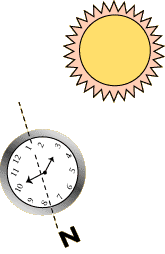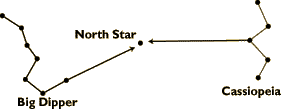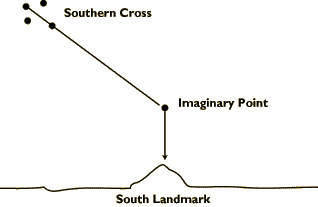The Shadow Tip
Find a straight stick about a meter long and
locate a level spot with no brush in which a shadow will be cast.
Place the stick in the ground and mark the shadow's tip. Wait 10-15
minutes until the shadow tip moves a few centimeters and mark the
shadow tip's new position. Then draw a line through the two marks
to obtain an approximate east-west line. The first mark will always
be west. Stand with the first mark (west) to your left and the second
mark to your right. You are now facing north.
Using a Watch
If you have a watch with hands, it can help
you find your way. The direction will be accurate if you are using
a true local time with no changes for daylight savings time. Also,
the further you are from the equator, the more accurate this method
will be. If you have a digital watch, all is not lost. Just draw
a circle on a piece of paper with the correct time shown. Assuming
you are in the northern hemisphere, hold the watch horizontal and
point the hour hand at the sun. Bisect the angle between the hour
hand and the 12:00 mark to get a north - south line. If you have
trouble deciding which end of the line is north, remember that the
sun rises in the east and sets in the west. It is due south at noon,
east before noon, and west after noon. Note: If your watch is set
on daylight savings time, use the midway point between the hour
hand and the 1:00 mark to determine the north - south line.
The Night Sky


To locate the North Star, the Big Dipper (Ursa
Major) and Cassiopeia are helpful, because neither of these constellations
ever sets and thus are always visible on a clear night. After finding
the North Star, imagine a line drawn from the North Star perpendicular
to the earth. The point at which the line reaches the horizon is
north.
There isn't a star bright enough to be easily
recognized near the south celestial pole, so you can use instead
a constellation known as the Southern Cross. It has five stars,
of which the brightest four form a cross that tilts to one side.
The pointer stars are the ones that form the long axis of the cross.
Determine south by imagining a distance five times that of the two
pointer stars. The end of the imagined line is in the general direction
of south. Look to the horizon for a landmark to steer by.
Moon-You can use the moon to determine
a rough east - west direction. If the moon rises before the sun
sets, the illuminated side will be west. If the moon rises after
midnight, the illuminated side will be east.
Moss- The old saying that moss grows
on the north side of a tree is only partially accurate. Moss does
grow on the north side of a tree; however, it also grows on the
south and all the way around. In reality, moss growth is more vigorous
and lush on the side of the tree facing the equator.
Vegetation and Moisture-North-facing
slopes receive less sun than south-facing slopes and are therefore
cooler and damper. In the summer, north-facing slopes retain patches
of snow. In the winter, trees on south-facing slopes are the first
to lose snow and the ground snowpack is more shallow.
Making a Compass-Use a piece of ferrous
metal that can be shaped into a needle or use a double-edged razor.
You will also need a piece of non-metallic string from which to
suspend the metal. Polarize the needle by slowly stroking it in
one direction through your hair, using deliberate strokes. You can
also polarize the needle by stroking it repeatedly at one end with
a magnet, rubbing in one direction only. If you have a 2 volt or
higher battery and some wire, you can polarize the needle electrically.
If the wire isn't insulated, wrap it in paper to prevent contact.
Coil the wire and place the ends on the battery's terminals. Repeatedly
insert one end of the metal object in and out of the coil. The needle
will become an electromagnet. When suspended from a non-metallic
string or floated on a small piece of wood in water, the needle
will align itself with a north - south line.